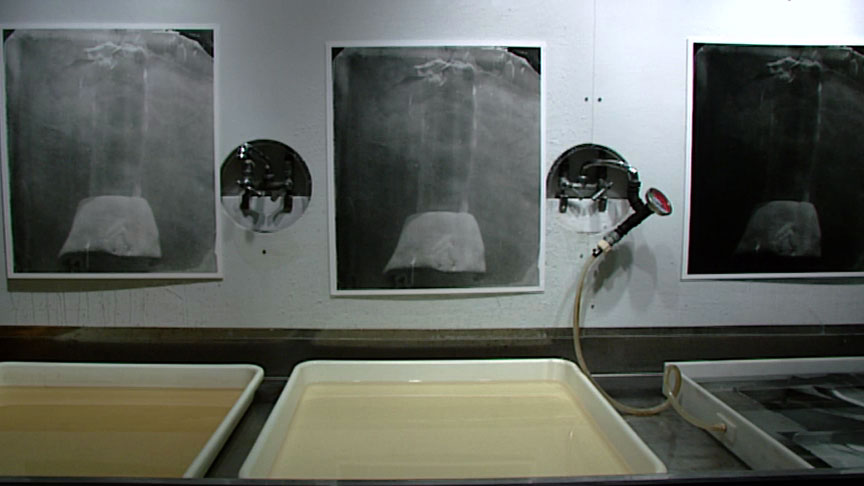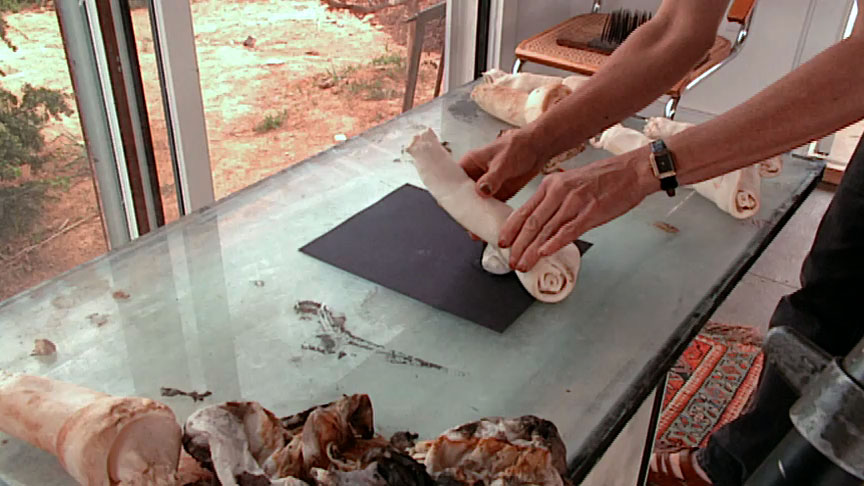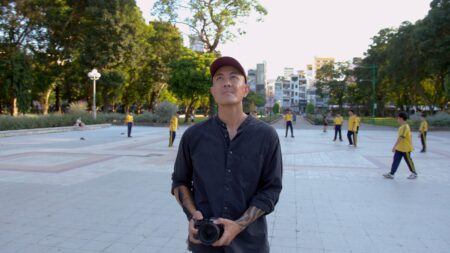Interview
Dog Bone Prints

Sally Mann in her Lexington, Virginia home, 2000. Production still from the "Art in the Twenty-First Century" Season 1 episode, "Place," 2001. © Art21, Inc. 2001.
Artist Sally Mann discusses her series of dog bone prints and their place within the history of photography.
ART21: Could you talk about the dog bone prints?
MANN: If I could be said to have any kind of aesthetic, it’s sort of a magpie aesthetic. I just go and I pick up whatever is around. If you think about it—the children were there, so I took pictures of my children. It’s not that I’m interested in children that much or photographing them. It’s just that they were there. And it’s the same with dog bones. I just had dozens of dog bones all over my living room floor, so I photographed them. In fact, I was sort of looking at those dowels over there and thinking, “You know, I bet I could make a good picture out of that pile of dowels.”
It’s just this sort of little magpie thing—that something will catch my eye and I’ll go for it. They don’t have any real meaning; it’s just that they have an allure, somehow. The texture and all that stuff that catches your eye, I guess. That leads us into a segue for something we probably don’t need to get into now, but there’s something about the way I approach photography which is very spontaneous. I mean, I see a dog bone, I bring it in, I take a picture; I like the picture. I’ll show you the first picture I took: I thought, “Hey, that’s a pretty good picture.”
So, then I go collect all the other dog bones, and I bring them in and I take a few more pictures, and then I put them on the wall. And then, before long, the gallery says, “Well, let’s do a show of dog bones.” So, we do a show of dog bones, and then some cynical postmodern critic will come along and say, “Oh my god, look at the show of dog bones; what do you suppose it means?” And it means that I want to see what dog bones look like, photographed.
The same thing happened with the pictures of the children: they were just photographs of my children doing what children do, and they got layered with all of this, often absurd, psychological stuff. You know, these sort of guys sitting around in Yale, stroking their beards with their little leather coated jackets saying, “Well, it must mean this . . .” It means that I was a mother taking pictures of my children. Anyway, I’m just taking pictures of dog bones.
ART21: Can you talk about the use of ordinary objects in the history of photography?
MANN: I keep thinking of Irving Penn and those cigarette butts he did. They’re enough like those pictures that I’m a little daunted in this pursuit. When they go up on the wall, I can see all those critics saying, “Oh yes, but Irving Penn did this fifteen years ago. Why is she even bothering?”

Sally Mann in her Lexington, Virginia home, 2000. Production still from the “Art in the Twenty-First Century” Season 1 episode, “Place,” 2001. © Art21, Inc. 2001.
ART21: Is there anyone else who has specifically influenced this series of photographs?
MANN: I look at a lot of people’s work. I mean, I’m a shameless borrower. But in this case, it happened so spontaneously that I didn’t actually say, “Oh, maybe I’ll take a picture just like that Irving Penn I remember being so good.” These dog bones are just making art the way art should be made, I think, without any overarching reference. Just for fun, if you can imagine that. Art for fun. Sometimes it is fun.
ART21: What do these dog bone prints remind you of?
MANN: Actually, what I like about these dog bones is their ambiguity, because you can’t tell what size they are. First of all, you don’t know what they are. And second of all, they almost look like big, massive, carved stones. You know, if it doesn’t have ambiguity, don’t bother to take it. I love that, that aspect of photography—the mendacity of photography. It’s got to have some kind of peculiarity in it, or it’s not interesting to me. I have to admit, the dog bones in the pictures look so massive—they look like Stonehenge or something, sitting there—so it takes you a while to figure out what they are, or maybe you don’t figure it out. I guess, unless you come in here, you don’t. So, maybe they’ll think I’m photographing Brancusi sculptures.

Sally Mann in her Lexington, Virginia home, 2000. Production still from the “Art in the Twenty-First Century” Season 1 episode, “Place,” 2001. © Art21, Inc. 2001.
ART21: Is there anything else about your photographic process that you would like to add?
MANN: You mean the moment that’s just enough time to make your quick prayer? There is something about this process—and about the whole 8-by-10 business—that takes it out of the arena of the snapshot, even though, of course, I’m always desperate for that feeling. I wanted those family pictures to look effortless; I wanted them to look like snapshots. And some of them did. My most successful pictures—I can show you which ones, I think, work the best—are the ones that just look like they were taken with a 35-millimeter [lens].
But it’s a process, and there’s a reverence that goes along with it—that you have to pay your dues to the photo gods, I guess. But there is a kind of reverence that goes along with doing this process. Of course, it has all that vestigial stuff that goes with it. I mean, you can’t do this without thinking, “Oh, Carlton Watkins and all those men in their wagon trains pulled by mules, out there, in the blistering heat, with no running water.” Maybe the gods that you’re paying reverence to are those, the ones that preceded you, because it’s an extraordinarily difficult process in the field.
This interview was originally published on PBS.org in September 2001 and was republished on Art21.org in November 2011.



